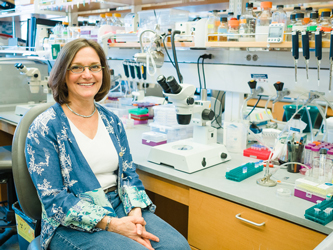Abby Dernburg

Howard Hughes Medical Institute Investigator and Professor of Cell Biology, Development and Physiology*
*Affiliate, Division of Genetics, Genomics and Development; And Senior Scientist, Life Sciences Division, Lawrence Berkeley National Laboratory
Research Interests
Chromosome dynamics during meiosis: Genetic information is encoded within chromosomes, enormous DNA molecules that self-organize through association with a myriad of proteins. This organization is highly dynamic, which enables the genome to accomplish diverse tasks, including gene expression, replication, repair, and transmission of information to the next generation. Our lab is interested in the relationships between chromosome structure and function. We focus on chromosome behavior during the special cell division process of meiosis, which is required for sexual reproduction. Much of our work is done using the powerful model organism Caenorhabditis elegans, which enables us to combine genetics, cell biology, and genomic approaches.
Current Projects
Dissecting the function of meiotic Pairing Centers: Work in our lab has revealed that the interactions between homologous chromosomes during meiosis depend on the activities of special regions on each chromosome called meiotic "Pairing Centers." We discovered that these regions, which each span 120kb-1Mb or more of the genome, contain a high density of binding sites for a family of unusual zinc finger proteins called HIM-8 and ZIM-1, -2, and -3. During early meiotic prophase, these proteins connect the chromosomes through the nuclear envelope to the microtubule cytoskeleton. We have found that these connections are essential to promote chromosome movement and to coordinate homolog pairing and synapsis. Using a variety of approaches, we are working to better understand this highly dynamic stage of meiosis, and to learn more about the structure and function of Pairing Centers. For example, we are currently investigating the contributions of Pairing Centers to nuclear architecture and the regulation of meiotic progression, and how chromatin organization might impact these sites' functions during meiosis.
Meiotic chromosome dynamics in vivo: A major goal of our lab is to understand the mechanical forces that push and/or pull on chromosomes, and how these properties contribute to complex tasks such as homolog pairing and the regulation of recombination. Because C. elegans is optically transparent, we have the opportunity to observe these dynamic events as they occur in living animals. We are developing new fluorescent reporters to observe diverse aspects of chromosome dynamics using high-resolution 4-D microscopy. In parallel, we are developing methods to observe and describe chromosome dynamics quantitatively. Through our work on Pairing Centers (above), we have identified molecular components involved in meiotic chromosome dynamics, and we are using these approaches to more precisely define their roles.
Chromatin organization and meiotic functions: We are currently working on the modENCODE project, through a collaboration with several other C. elegans labs. The goals of our group are to understand the sequence features that control the association of chromatin proteins with the C. elegans genome. Our lab is particularly interested in how meiosis-specific features of chromosome architecture are established, and how they contribute to the essential processes of chromosome pairing, synapsis, and recombination.
Evolutionary aspects of meiosis: A relatively new venture for our lab is to investigate how key aspects of meiosis have been conserved or altered through evolution, and how meiosis itself contributes to the evolutionary process. We are currently exploring these issues though two new projects. In one project, we are investigating molecular mechanisms of meiosis in an emerging model organism, the planarian Schmidtea mediterranea, and a closely related species, Schmidtea polychroa. As in C. elegans, chromosomes establish physical connections to the nuclear envelope during meiosis in flatworms. Despite the evolutionary distance between flatworms and roundworms, we have recently found that the role of these connections in coordinating homolog pairing and synapsis during meiosis is conserved. In other work, we are exploring how meiotic mechanisms might contribute to reproductive isolation and speciation within the nematode lineage.
Selected Publications
Sato, A., Isaac, B., Phillips, C.M., Rillo, R., Carlton, P.M., Wynne, D.J., Kasad, R.A., and Dernburg, A.F. (2009). Cytoskeletal forces span the nuclear envelope to coordinate meiotic chromosome pairing and synapsis. Cell 139, 907-919.
Hiraoka, Y., and Dernburg, A.F. (2009). The SUN rises on meiotic chromosome dynamics. Dev Cell 17, 598-605.
Phillips, C.M., Meng, X., Zhang, L., Chretien, J.H., Urnov, F.D., and Dernburg, A.F. (2009). Identification of chromosome sequence motifs that mediate meiotic pairing and synapsis in C. elegans. Nat Cell Biol 11, 934-942.
Bhalla, N., and Dernburg, A.F. (2008). Prelude to a division. Annu Rev Cell Dev Biol 24, 397-424.
Bhalla, N., Wynne, D.J., Jantsch, V., and Dernburg, A.F. (2008). ZHP-3 acts at crossovers to couple meiotic recombination with synaptonemal complex disassembly and bivalent formation in C. elegans. PLoS Genet 4, e1000235.
Carlton, P.M., Farruggio, A.P., and Dernburg, A.F. (2006). A link between meiotic prophase progression and crossover control. PLoS Genet 2, e12.
Phillips, C.M., and Dernburg, A.F. (2006). A family of zinc-finger proteins is required for chromosome-specific pairing and synapsis during meiosis in C. elegans. Dev Cell 11, 817-829.
Bhalla, N., and Dernburg, A.F. (2005). A conserved checkpoint monitors meiotic chromosome synapsis in Caenorhabditis elegans. Science 310, 1683-1686.
Phillips, C.M., Wong, C., Bhalla, N., Meneely, P., and Dernburg, A.F. (2005). HIM-8 binds to the X chromosome Pairing Center and mediates chromosome-specific meiotic synapsis. Cell 123: 1051-63.
MacQueen, A.J., Phillips, C.M., Bhalla, N., Weiser, P., Villeneuve, A.M., and Dernburg, A.F. (2005). Chromosome sites play dual roles to establish homologous synapsis during meiosis in C. elegans. Cell 123, 1037-1050.
Photo credit: Mark Joseph Hanson of Mark Joseph Studio.
Last Updated 2010-01-10